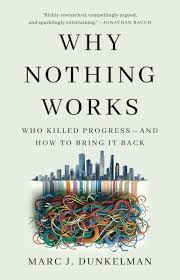[Editor's note: This article first appeared at John’s Newsletter: Thoughts about Contemporary Culture, Higher Education, Politics, and Religion. John’s
Newsletter is a reader-supported publication. To receive new posts and
support his work, consider becoming a free or paid subscriber.]
A quick note today because I’m heading to downtown Denver for an event sponsored by UCCS’ Center for the Study of Evangelicalism. Titled “White Christian Nationalism & the Future of American Politics”, the event features Anthea Butler and Randall Balmer. I would go here either one of them speak but having them together is a real treat. And I don’t have to drive to Colorado Springs to hear them! Watch for my reactions on Monday’s SubStack.
I’ve only read the introduction so far, but I’m intrigued by his initial argument. And I that argument speaks both to the Christian Nationalism I’ll hear about tonight and what has been happening in Trump 2.0.
Dunkleman argues that progressives have been driven by two somewhat contradictory political philosophies. While a balance between them is desirable, too often we’re faced with a pendulum swing.
It’s not a perfect match, but he contrasts the concerns of Hamilton with those of Jefferson. Hamilton favored a centralized authority to avoid chaos — that government could ameliorate problems on the ground. Jefferson, on the other hand, was worried about the government tyranny he’d seen from King George.
Alexander Hamilton, leader of the Federalists, worried primarily about chaos. He wanted to place more authority in the hands of centralized officials and financiers capable of developing America into an industrial dynamo — a “Hercules” on the global stage. His worry was that America woudl remain too disorganized, too divided, too chaotic to make the most of its opportunity. Pulling power into a leadership class would deliver more fro the public.
Thomas Jefferson’s narrative, by contrast, was born of an entirely different frame. Horrified by the English Crown’s treatment of the colonies, he was determined to thwart overbearing authority — to protect individuals (or, at least, white, male, landowning individuals) from the abuses of public authority. (10)
For Hamilton’s frame, one sees problems that need to be addressed in the society and launches strategies to solve those problems. So the Interstate Highway system, the EPA, FEMA, Social Security, are all organized government efforts to deal with concrete problems that span local control. Power, in this frame, can be a source for good.
The Jeffersonian fear is that concentrated power in the hands of few is prone to abuse, corruption, and capriciousness. Far better to shove power downstream, to let local entities deal with problems as they see fit, recognizing the presumed wisdom of thsoe at the local level. Power, in this frame, is fraught with concern.
Of course, we have to include the Jacksonian impulse of attacking centralized authority and allowing ethnic grievances to run rampant. I think Trump 2.0 is a Jacksonian philosophy (to the extent that there is one) pretending to be Jeffersonian.
The latter comes clear in the current destruction of much of structdure of the federal government. Under the guise of “returning things to the states”, large swaths of federal programming will be shifted downward. This will allow the administration to claim that they cut government spending. In reality, they will decrease federal spending while increasing financial burdens of states and localities. Because these latter groups cannot deficit spend, services will be cut or local taxes will increase — or both.
Make no mistake. A cursory review of the daily executive orders makes clear that this is Jacksonian government. From singling out supposed enemies to immigration policies to attacks on the Smithsonian and higher education, pursuing populist agendas (or personal ones) is key.
In the process, the checks and balances of a true Jeffersonian approach are missing. With the exception of the courts, none of the structures designed to protect against centralized tyranny are completely ineffective (so far).
When power is pushed down to localities, it opens the door for conservatives at the local level to use their gerrymandered power to pursue their agendas regardless of the interests of their constituents. So we get abortion bans, book bans, and bathroom bills in some states with a different set of operating priorities in others.
Conservative activists have seen this coming for decades. They get conservative Christians to dominate local school boards. They build horizontal structures that allow information to flow from one state/locality to another.
This is where the Christian Nationalism movement comes in. It’s not just individuals who hold certain attitudes about Christian morality and its relationship to government. It exists in organizations that cut across those groups, to exercise power from the grassroots.
The Hamiltonian vision will rise again. Unfortunately, it will happen as problems go unresolved and people are harmed. The chaos that Dunkelman describes is on the horizon. What happens when FEMA only operates at the state level and people can’t get home insurance? What happens when the measles epidemic in several states becomes a nation-wide phenomenon? What will result when educational quality falters even further?
I really wish there was a clear way to swing the pendulum back toward balance without multiple crises to happen first. But I don’t think things will change without first seeing widespread pain and chaos.

No comments:
Post a Comment